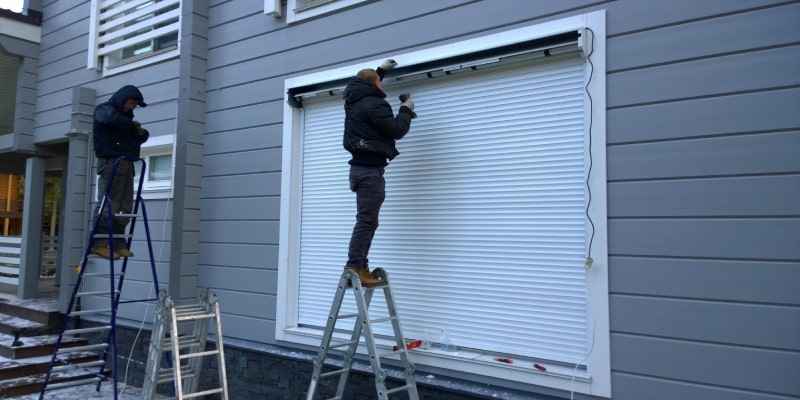Do-it-yourself (DIY) shutter repair can be a great way to save money and time. It can also be a fun and rewarding project for those who enjoy home improvement projects. However, due to the complexity of the task, it is important to take the necessary precautions. Here are five DIY tips for shutter repair that will help ensure that your project is successful.
DIY Shutter Repair:
- Inspect for Damage: Before you start repairing your shutters repair, it’s important to inspect them thoroughly to determine the extent of the damage. Check for cracks, chips, and other signs of wear and tear that could compromise their functionality.
- Tighten Loose Screws: If you notice any loose screws, use a screwdriver to tighten them up. This will help to prevent further damage and ensure that your shutters stay in place.
- Replace Broken Slats: If one or more slats are broken, you can replace them by removing the damaged slat and inserting a new one in its place. Be sure to measure carefully so that the replacement slat fits perfectly.
- Sand Down Rough Spots: If there are any rough spots or splinters on your shutters, sanding them down can help improve their appearance and prevent further damage.
- Repaint or Refinish: Finally, consider repainting or refinishing your shutters to give them a fresh look and protect them from further wear and tear. Make sure to choose a paint or finish that is appropriate for outdoor use and matches the existing color scheme of your home’s exterior.
Step 1: Assess Damage:
The first step in any shutter repair project is to assess the damage. This will help you determine the extent of the repairs that need to be made and what materials you will need for the job. Begin by closely examining your shutters for any signs of damage, such as cracks, chips, or warping. Be sure to check all parts of your shutters, including the hinges and hardware. If your shutters are damaged beyond repair, you may need to replace them entirely. However, if there is only minor damage, it could be a simple fix that you can do yourself with just a few tools and some spare time. Once you have assessed the damage and decided on a course of action, make a list of all necessary materials and tools so that you are fully prepared before beginning your repair project.
Remember to approach each shutter individually when assessing their condition as they may differ in terms of damages or wear-and-tear. By carefully evaluating each shutter separately before embarking on repairs or replacement projects, homeowners can save themselves time and money while ensuring high-quality workmanship overall.
Step 2: Clean & Prepare:
After assessing the damages on your shutters, the next step is to clean and prepare them for repair. This step may seem like a simple task, but it plays a crucial role in ensuring that your shutter repair service job is successful.
To start with, remove any debris or dust from the affected area using a soft-bristled brush or cloth. If there are any loose screws or nails, take them out and keep them aside for later use. Next, sand down any rough edges using fine-grit sandpaper to create smooth surfaces that will promote better adhesion when you apply putty or paint.
After cleaning and preparing your shutters for repair, ensure that they are dry before proceeding to the next step. Dampness can affect the quality of repairs by hindering proper binding of materials used during restoration. Once you have completed this step successfully, you are now ready to start repairing your shutters!
Step 3: Replace Damaged Parts:
Replacing damaged parts is an essential step in shutter repair london . Before replacing anything, you should conduct a thorough inspection to determine the extent of damage and the specific part that needs replacement. Commonly damaged parts include louvers, hinges, tilt rods, and shutter stiles. Replacing louvers involves removing the old ones and inserting new ones into their designated slots. Hinges are replaced by unscrewing them from the frame and attaching new ones in their place. Tilt rods can be removed by sliding them out of their brackets and inserting a new one.
Shutter stiles can be more complicated to replace, as they support the structural integrity of the shutters. If only a small portion is damaged, you may be able to patch it up with wood filler or glue. However, if it is beyond repair, you will need to remove it entirely and install a new one in its place using screws or dowels for added support. By properly replacing damaged parts during shutter repair, your shutters will look as good as new and function well for years to come.
Step 4: Reattach Components:
Now that you’ve cleaned, replaced, or repaired any damaged components of your shutters, it’s time to reattach them. Start by lining up the hinges and securing them in place with screws. Make sure to tighten them firmly but not too tight as this can cause damage. Next, attach the shutter panels back onto the hinges by slotting them into place and securing with pins or screws. Check that each panel is levelled correctly and aligned properly before tightening everything up.
Finally, test your shutters by opening and closing each panel to ensure they are functioning properly. If there are any issues such as panels sticking or not closing fully, make adjustments until everything is working smoothly again. By following these simple steps for reattaching the components of your shutters after repair work, you can ensure their longevity and proper function for years to come.
Step 5: Test & Verify:
After completing the shutter repair, it is important to test and verify that everything is working as intended. This step ensures that you have fixed the issue completely and there are no underlying problems left behind. First, visually inspect the shutters to ensure they are in their correct positions and aligned with each other. Next, test the operation of the shutters by opening and closing them multiple times.
During this process, check if there are any unusual noises or resistance while operating the shutters. If there are issues such as stiffness or difficulty in opening/closing, examine and identify the problem area before proceeding with further repairs. Lastly, verify that all locks and latches work properly to secure your shutters.
Testing and verifying your shutter repair will help you avoid future issues by ensuring a proper fix has been achieved. It also provides peace of mind knowing that your shutters are now fully functional again for optimal security measures during harsh weather conditions.
Conclusion:
In conclusion, DIY shutter repair is a cost-effective way to keep your window treatments looking great. By following these five simple tips, you can easily tackle most minor repairs and maintenance tasks yourself. However, it’s important to know when a repair is too complex or dangerous for amateur work. If you’re ever unsure of your abilities or feel uncomfortable with a particular task, don’t hesitate to call in professional help. A certified repair technician can assess the damage and make recommendations for necessary repairs or replacements. Remember that regular maintenance is key to keeping your shutters looking and functioning their best. By cleaning them regularly and addressing minor issues promptly, you can extend the life of your shutters and avoid more costly repairs down the line.


